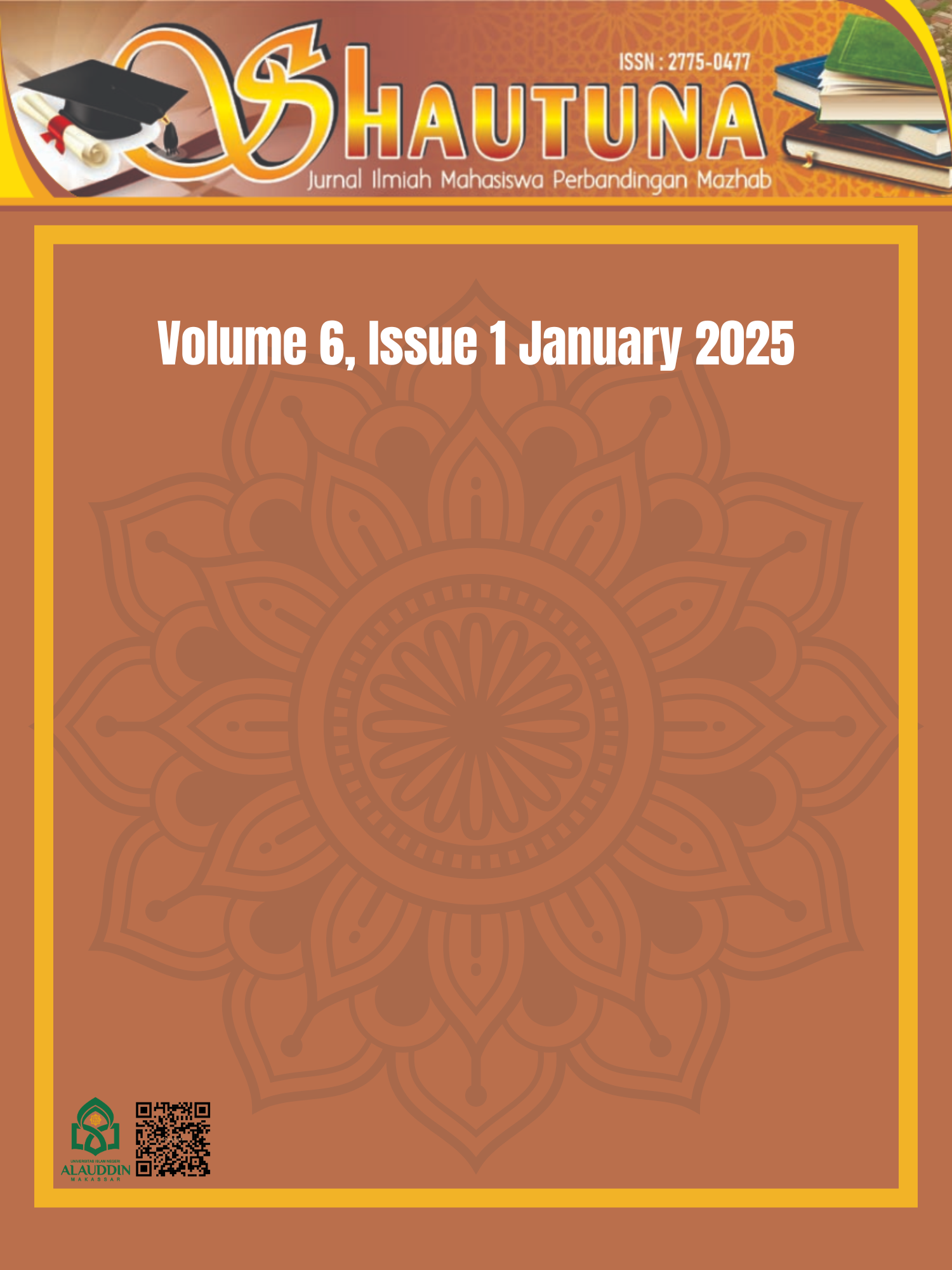Islamic Philanthropy and Positive Law Regulation
A Social Jurisprudence Study of the South Sulawesi Dompet Dhuafa Fund Donation Program
DOI:
https://doi.org/10.24252/shautuna.v6i1.52949Keywords:
Islamic Philanthropy, Positive Law Regulation, Social Jurisprudence, Fund Donation Program, Dompet DhuafaAbstract
This study aims to analyze the practice of cutting social fund donations by the Dompet Dhuafa Philanthropic Institute of South Sulawesi from the perspective of social fiqh and positive law. The focus of this research includes the mechanisms of fund management by philanthropic institutions, as well as how these practices are normatively reviewed in the context of Islamic law and national regulations. This study uses a qualitative approach with a field study method. Data was collected through observation, in-depth interviews, and documentation, which was then strengthened by literature studies of laws and regulations, scientific literature, and information from the official websites of related institutions. Data analysis is carried out through the stages of data reduction, data presentation, and drawing conclusions. The results of the study show that Dompet Dhuafa South Sulawesi collects funds from ZISWAF and Corporate Social Responsibility (CSR) sources, with an allocation of 12.5% for operational needs and amil rights. From the perspective of social fiqh, the deduction is justified based on the provisions in QS. At-Taubah verse 60 and MUI Fatwa No. 8 of 2011, which stipulates the share of amil at 12.5%, in line with the views of scholars such as KH. Sahal Mahfudh and KH. Ali Yafie who emphasized the importance of optimizing zakat institutions in community empowerment in accordance with the principles of maqāṣid al-syarīʿah. Meanwhile, in the context of positive law, the deduction of social funds by Islamic philanthropic institutions is regulated in Article 67 paragraph (2) of Government Regulation No. 14 of 2014 as a derivative of Law No. 23 of 2011, and strengthened by the Decree of the Ministry of Religion No. 733 of 2018 and BAZNAS Regulation No. 1 of 2016, which allows deductions of up to 20% outside of zakat funds. On the other hand, public philanthropic institutions or Money and Goods Collection Institutions (PUB) are subject to Government Regulation No. 29 of 1980 and Permensos No. 8 of 2021, which limit operational costs to a maximum of 10% without specific regulations regarding the salary of administrators. This research emphasizes the need for regulatory distinction between Islamic and public philanthropic institutions, as well as the strengthening of transparency in the management of social funds to maintain public trust and the effectiveness of aid distribution.
References
Al-Rasyidi, Firdaus Syah Indra. “Efektivitas Pendistribusian Dana Zakat, Infak, Dan Sedekah Melalui Program BAZNAS Tanggap Bencana Pada Badan Amil Zakat Nasional Pusat.” Fakultas Dakwah dan Ilmu Komunikasi Universitas Islam Negeri Syarif …, n.d.
Arianty, Fitria, S Sos, Elsie Sylviana Kasim, S Sos, Hadining Kusumastuti, S Sos, M Ak, and Sandra Aulia. Perpajakan Dan Corporate Citizenship. Nas Media Pustaka, 2024.
Badruddin, Ahmad. “Filantropi Korporasi Dalam Perspektif Al-Qur ‘An.” Institut PTIQ Jakarta, 2023.
Firdaningsih, Firdaningsih, and Rahmad Hakim. “Delapan Golongan Penerima Zakat Analisis Teks Dan Konteks.” Equilibrium: Jurnal Ekonomi Syariah 7, no. 2 (2019): 316.
Hafnizar, Anggi Aulia. “Analisis Penerapan Akuntansi Zakat Pada Lembaga Amil Zakat (Studi Kasus Nurul Hayat Medan).” Universitas Islam Negeri Sumatera Utara Meddan, 2018.
Ishak, Nurul Syahidah Binti. “Muzakki (Analisis Dalil-Dalil Hadis Dalam Kitab-Kitab Hadis Dan Dalil-Dalil Hadis Dalam Kitab-Kitab Fikih).” UIN Ar-Raniry Fakultas Syariah dan Hukum, 2024.
Janah, Unun Roudlotul, Muchtim Humaidi, and M IRKH. “Filantropi Pada Masyarakat Multikultural.” Repository. Iainponorogo. Ac. Id, 2021.
Kusuma, Airlangga Surya, Fadhli Suko Wiryanto, and Purwanto Widodo. “Analisis Kontroversi Aksi Cepat Tanggap Berdasarkan Perspektif Maqashid Syariah.” Jurnal Indonesia: Manajemen Informatika Dan Komunikasi 5, no. 3 (2024): 2484–95. https://doi.org/10.35870/jimik.v5i3.949.
Majid, Afirah, Zulhasari Mustafa, Arif Rahman Ramli, and Atriani Lukman. “Supervision Model of Social Fund Collection Institutions at the Dompet Dhuafa Foundation: Perspectives on Positive Law and the Al-Shafi’i School.” Shautuna: Jurnal Ilmiah Mahasiswa Perbandingan Mazhab 5, no. 1 (2024): 299–315. https://doi.org/10.24252/shautuna.v5i1.39913.
Nursalsabillah, Annisa, Atwar Bajari, and Yanti Setianti. “Komunikasi Strategis Dompet Dhuafa Dan Baitulmaal Munzalan Dalam Menghadapi Isu.” Jurnal Komunikasi 14, no. 2 (2023): 181–91. https://doi.org/10.31294/jkom.v14i2.15432.
Rassanjani, Saddam, and Dahlawi Dahlawi. “Zakat Dan Kedermawanan Sebagai Bentuk Partisipasi Masyarakat Dalam Perlindungan Sosial Selama Pandemi.” Sosio Informa 8, no. 2 (2022).
Rohaeni, Heni, and Risma Oktaviani. “Analisis Pelaksanaan Mutasi Jabatan Pada Divisi EMCA Kantor Pusat PT. Kereta Api Indonesia (Persero).” In Laboratorium Administrasi Publik 2017, 237, 2017.
Rokhmawati, Kamiliya. “Analisis Pola Penyaluran Zakat Pada Lembaga Amil Zakat (Studi Komparatif LAZ DKD, BAZNAS, Dan Lazismu Kabupaten Magelang).” Universitas Islam Indonesia, 2023.
Sektiono, Dwi, and Rini NUGRAHENI. “Implementasi Good Governance Pada Lembaga Swadaya Masyarakat (Studi Kasus Pada Aksi Cepat Tanggap Cabang Semarang).” UNDIP: Fakultas Ekonomika dan Bisnis, 2016.
Sugianto, Heri. “Analisis Pendapat Empat Mazhab Tentang Zakat Fitrah Dengan Uang Tunai.” UIN Raden Intan Lampung, 2018.
Suhartini, Nani. “Analisis Penerapan PSAK 109 Dan Audit Syariah KMA RI No. 733 Tahun 2018 (Studi Kasus Laz Al-Azhar Peduli Ummat).” Jurnal Manajemen Bisnis Dan Organisasi 2, no. 1 (2023): 11–23. https://doi.org/10.58290/jmbo.v2i1.83.
Downloads
Published
How to Cite
Issue
Section
License
Copyright (c) 2025 Muhammad Wildan, Asni Asni, Nur Taufiq Sanusi

This work is licensed under a Creative Commons Attribution 4.0 International License.









